Hiroshima at that time
Air-raid Warning Siren
Starting around fall of 1944, the U.S. military planes flew over Japan's air space to carry out air raids. When a fighter plane approached an area, an air-raid warning siren sounded and people ran to air-raid shelters for cover.
In 1945, the U.S. military attacked the major Japanese cities from the air, one after another. The air strikes did severe damage. Though sirens sounded in Hiroshima as well, air strikes were rare.
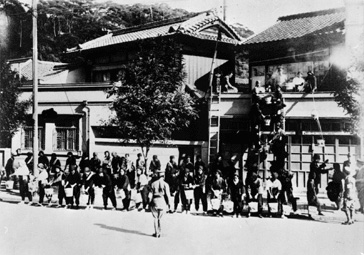
Air-raid drill conducted by Hijiyama Neighborhood Association in Hiroshima.Hiroshima began air-raid training as early as 1932, but full-scale drills did not begin until 1937. Civil Defense Teams were established as air defense organizations. They organized city residents into compulsory practice sessions for taking shelter and fighting fires with bucket relays.
1942
Collection of Minoru Yamamoto
Courtesy of Hiroshima City
People Living in Hiroshima on that Day
As the Japanese military lost one battle after another on fronts in Southeast Asia and the Pacific Ocean, soldiers perished in great numbers. Filling the ranks required continually drafting new men. Left at home were women and children. The only males were schoolboys and elderly men.
Elementary schools had been renamed "national schools." National school students in the third grade and higher were sent to live apart from their families in mass school evacuations.
Students in junior high school and higher grades stayed in Hiroshima. All through summer vacation as well, they were required to work as laborers in building demolition or weapons factories.
School Evacuations
As part of urban airdefense, children throughout the city were evacuated─taken from their houses and given shelter in the homes of people they knew in farm villages. If they lacked such a personal connection, they went with their school groups to live in village temples or inns.
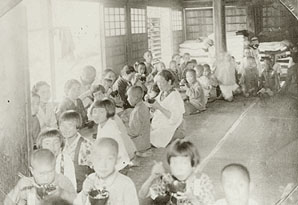
Evacuated students from Nobori-machi National School
July 15, 1945
Collection of Haruko Yokoue
Courtesy of Hiroshima Municipal Archives
Building Demolition
To suppress fires in the event of an air raid, some buildings in densely packed areas were demolished to create firebreaks. Called out for the demolition projects were students in junior high school and higher grades, as well as many town and village residents in the Hiroshima vicinity.
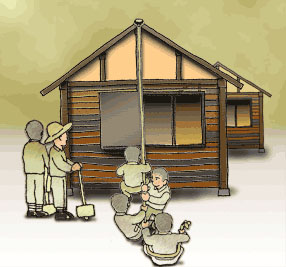
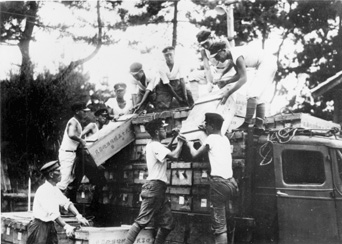
Students mobilized to work at the Hiroshima Army Ordnance Supply Depot;around 1943
Collection of Hiroshi Yano
Courtesy of Hiroshima City
Because Hiroshima had so many military facilities, military personnel and foreign prisoners of war were in the city when it was bombed. So were many Koreans and people from Taiwan and the Chinese mainland who had been brought to Japan. All these are included in the estimated total number of about 350,000 people in Hiroshima at the time of bombing.
8:15 a.m., August 6
The world's first atomic bomb used against human beings was dropped in the sky over all these people.
The atomic bomb dropped on Hiroshima
The Bomb Called "Little Boy"
Through self-sustaining nuclear fission (chain reaction), an atomic bomb emits a huge amount of energy instantaneously.
The atomic bomb dropped on Hiroshima was a gun-type bomb. The uranium was divided into two pieces, both less than a critical mass and placed at either end of a cylinder. When one piece was fired into the other, critical mass was achieved.
Though the bomb was long and thin in shape, it grew shorter over the course of the project. Hence, the final bomb was called "Little Boy."
Atom: the smallest unit of matter
Nuclear fission
- When a neutron strikes a nucleus at the center of a uranium atom, the nucleus shakes violently, constricts, then divides.
- When the nucleus divides, neutrons are emitted with great energy.
- When the neutron flies off, it strikes other nuclei.
- 1., 2., and 3. are repeated.
As the fissionsplits many atoms each instant, it releases a tremendous amount of energy. The atomic bomb turns this energy into a weapon.
the fission
This fission process needs a certain
amount of uranium or other nuclear fuel
before it can repeat itself. That amount is called "critical mass."
Uranium has two primary isotopes, U-238 and U-235. These normally appear in a ratio of 99.3% for U-238 to 0.7% for U-235. To make uranium fuel for a bomb, the uranium must be "enriched," that is, have a higher percentage of U-235. The U-235 starts the nuclear chain reaction by sending out many neutrons to hit atomic nuclei.
Critical mass
The amount of uranium necessary to sustain a nuclear fission chain reaction
"Little Boy," the Atomic Bomb Dropped on Hiroshima
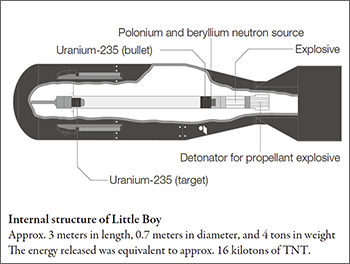
- When a neutron strikes a nucleus at the center of a uranium atom, the nucleus shakes violently, constricts, then divides.
- When the nucleus divides, neutrons are emitted with great energy.
- When the neutron flies off, it strikes other nuclei.
8:15 a.m.,August6
The Atomic Bombing
Hatsumi Sakamoto, 3rd grade, Elementary School ※
When the atomic bomb fell,
day turned to night and
people became ghosts.

"Fire," Panel 2 of The Hiroshima Panels
by Iri and Toshi Maruki
Collection of the Hiroshima Panels Foundation Maruki Gallery
※ In 1952, when this poem was published, Hatsumi Sakamoto was a third grader in Hijiyama Elementary School, Hiroshima City. This poem is published in From under the Atomic Cloud-A Collection of Poems (Aoki Shoten).

